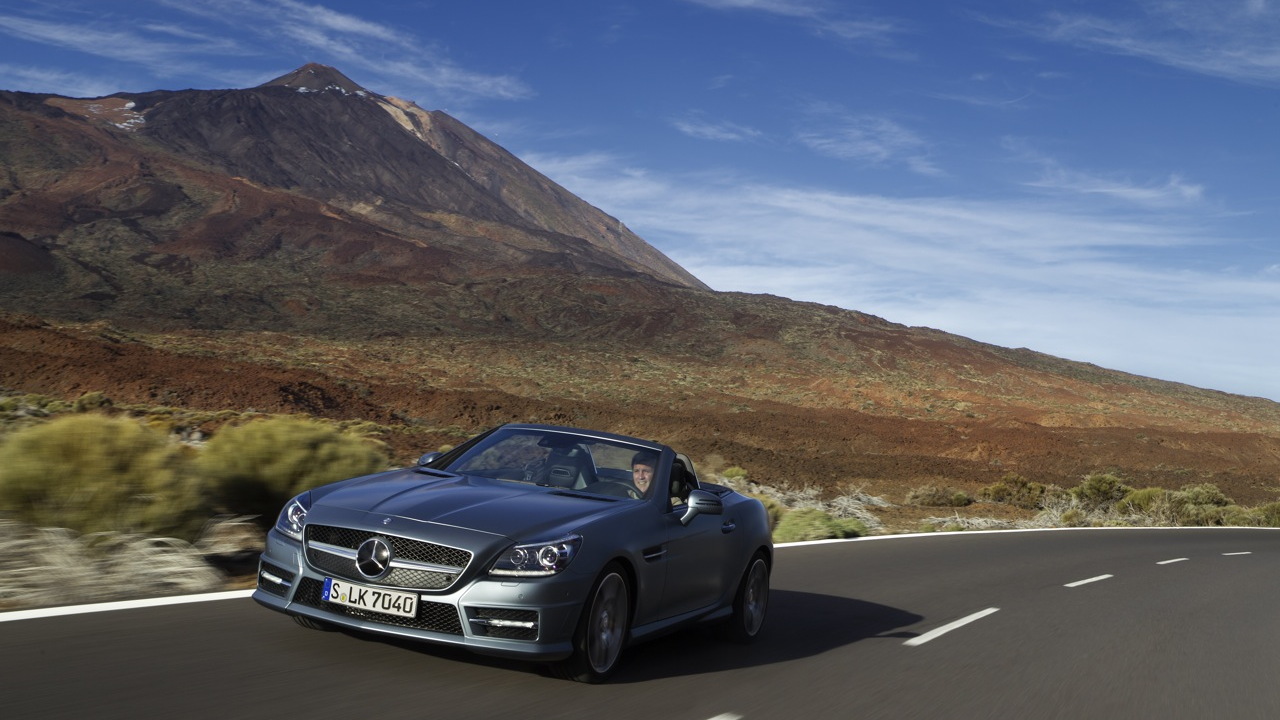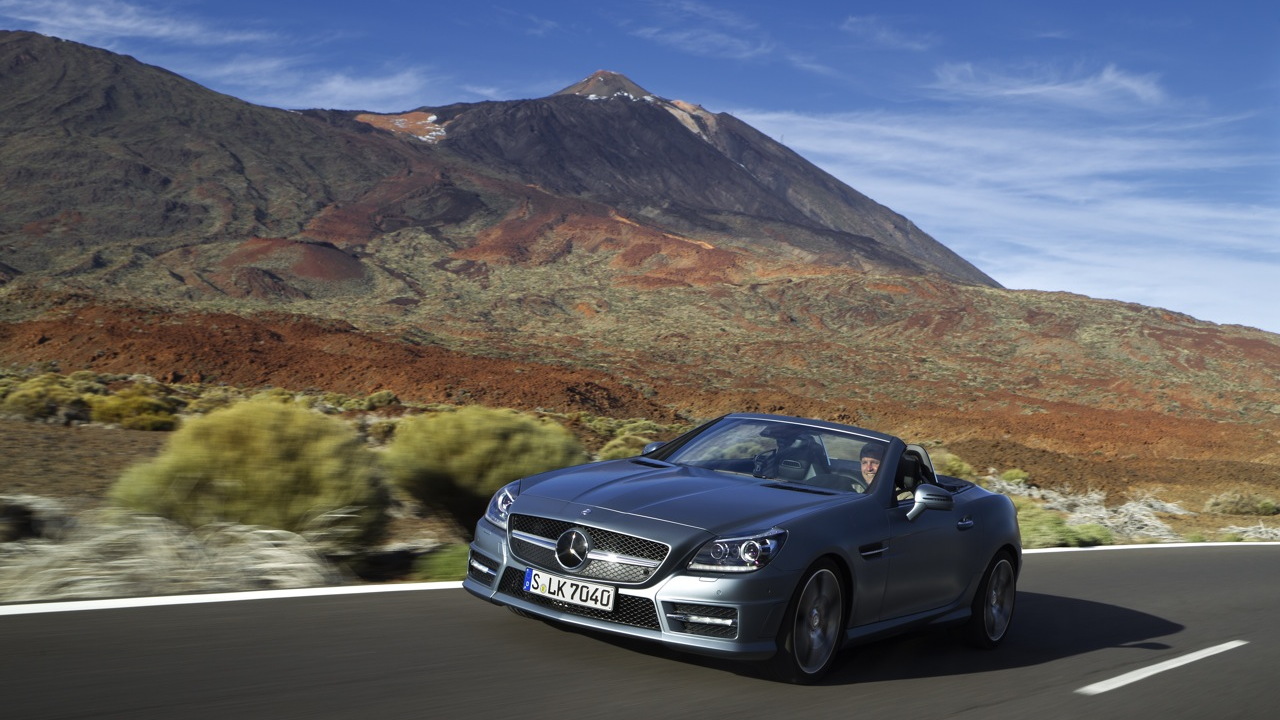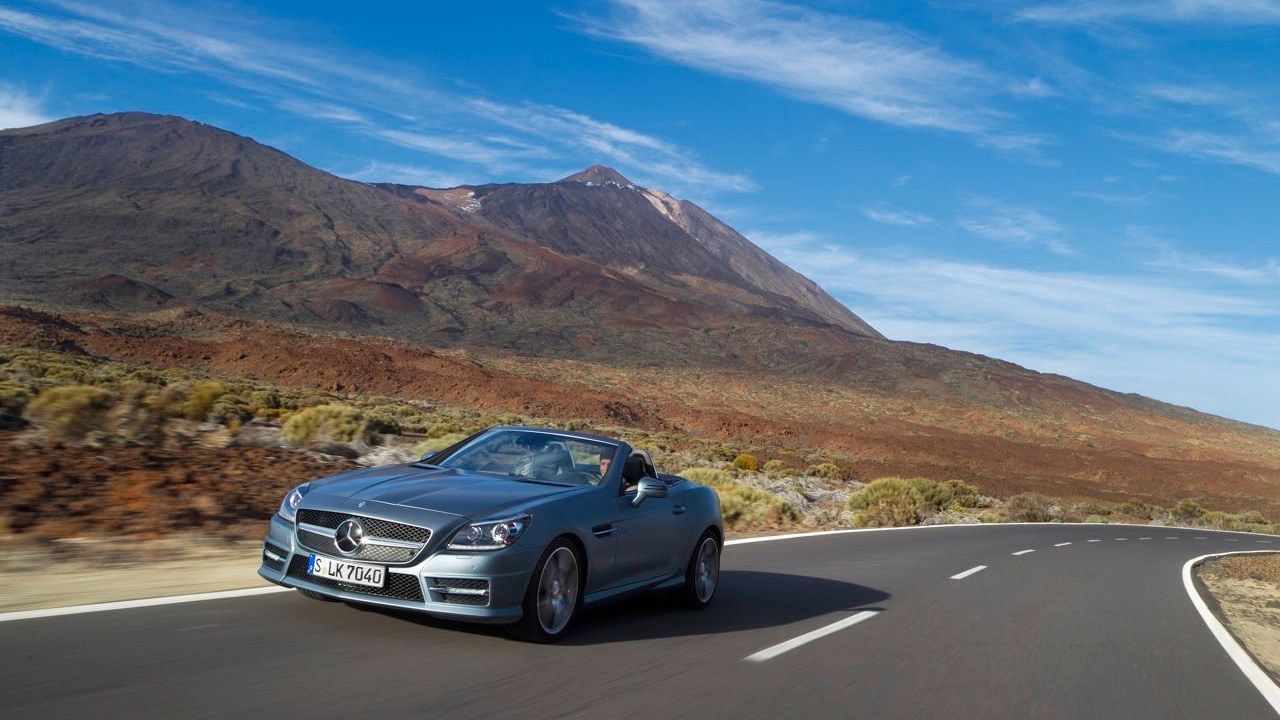Argue if you want in favor of the Porsche Boxster's no-compromises chassis, or the BMW Z4's now-outed closet speed freak. The SLK holds its own: it grips and grunts with its own visceral pulse--and hot-lapping the volcanoes and valleys of Spain's Tenerife Island proves that it's still a three-way arms race. And still a very small, very exclusive club.
With a new model comes an evolved look heavily influenced by the SLS AMG gullwing and the CLS four-door. A compact roadster like the SLK doesn't have as much room to let those styling themes play out in a purely elegant way, but there is a solidity and clarity to the new look that rises above the convertibles that came before it. From the front quarters, it's a more mature look than the under-detailed, first-gen car, and a welcome step back from the overstyled second-generation roadster. The new front end sits taller, though: look at the SLK from the side and you can read the brutalist effect of new pedestrian-safety regs in its blunt grille and squared-off headlamps. The roof blisters over the body's wedge in a bare little bubble, same as ever, and tapers off into teardrop taillamps that create the most cohesive view--the one from behind. It's best when the roof is tucked in and the metallic twin peaks of the seat backs stand up at attention.
The cockpit's lost most of the metallic studded buttons that confused drivers, but it's traded them for more conventional black switches that still need to be learned before that first long road trip. The center stack reverts to a softly rounded, aluminum-clad look, capped by an LCD screen for audio displays. The screen goes high-resolution in vehicles equipped with COMAND, the wheel-driven controller that rests just under the driver's right wrist. Meaty metallic ribs flare from the flat-bottomed steering wheel, which has its own set of buttons for secondary controls like voice, audio and navigation, and metallic tubes house clean analog gauges remixed with some LCD readouts for the usual trip and gear functions.
By early next year, the SLK will once more be a three-act power play. The turbocharged, 201-horsepower 1.8-liter four-cylinder engine also found in the 2012 C-Class sedan arrives in February of 2012 in the SLK 250, likely as a 2013 model. With a six-speed manual or a seven-speed automatic option, this version could hit 60 mph in 6.5 seconds and a top speed of 155 mph, Mercedes estimates. Though it hasn't been confirmed or spec'ed out, an SLK AMG is a sure bet, probably powered by a 5.5-liter V-8.
When it launches this summer, the SLK 350 will have exactly one drivetrain to select from. It's a 302-horsepower 3.5-liter V-6, streaming out power through a seven-speed automatic to the rear wheels. The V-6 is a grunter, with the typical six-cylinder tenor that either dazzles you or leaves you wanting for a straight six, or better yet, a flat one. With a 0-60 mph time of 5.4 seconds and a top speed of 155 mph claimed by Mercedes, it's playing in the same awesome ballpark as the Boxster and Z4, though it falls shy of their aural come-ons.
The SLK's seven-speed automatic has three shift modes--Eco, Sport and Manual--and paddles as well as manual control via the shift lever. In Eco mode the shifts are long and syrupy; Sport is where you'll want to be most of the time, since it wakes up the tranny with the smoothest blend of fast gear changes. In Manual mode, some lumps surface in downshifts and sometimes even in upshifts, as the automatic gamely tries to swap up and down with the lightning reflexes of a dual-clutch box; the shift shock isn't too abrupt, but it makes ill-timed moves in mid-corner even more obvious. The SLK's shift paddles keep your hands on the wheel for the 180-degree wheel turns, but it's possible to bang off an upshift by backhanding the shift lever to the right, or to trigger a downshift with a pull to the left. One method makes far more sense, doesn't it?Fuel economy for the SLK350 is an estimated 20/29 mpg, though final EPA ratings aren't yet in. The SLK's gusto mashes up with a multi-link suspension with either conventional steel springs and shocks or with user-selectable shocks, as well as electrohydraulic steering with Direct Steer, which amplifies steering inputs according to the rotation angle of the steering wheel. The hybrid steering system leaves the usual Mercedes play of an inch or so on center for a more relaxed attitude on the highway, and works its way into aggression by the time you're a quarter-past in either direction.
We didn't drive the standard suspension setup, instead opting for the Dynamic Handling package and those continuously adjustable dampers. It lives up to the name, making the SLK almost tossable--it's not as lively as the Boxster, but that's admittedly a lofty target and not exactly a fair comparison, given the Porsche's mid-engine layout. On glassy roads in Tenerife, with the stability control put in its place (off), and the shocks set to Sport, the SLK's tires broke away softly and without much drama, easily corrected. It rounds off the worst peaks and divots to a nub with Sport mode disengaged; with Sport mode activated on a long uphill climb over crumbling asphalt, the SLK 350 only pounded a pothole or two, while it tugged and clawed away at hairpin after hairpin with a little help from deeply talented torque-vectoring brakes, which clamp an inside rotor to tighten cornering lines. The faintly exotic handling setup hits an ideal ballet-to-bully ratio that only gets better as you fling the tach over 3000 rpm up near the redline, and press its 18-inch, 35-series rear tires to put up, but not shut up.
With a wheelbase of 95.7 inches and an overall length of 162.8 inches, the 2012 SLK is nearly identically sized to the outgoing model. At 71.3 inches wide, it's grown a little broader, though the snug cockpit doesn't seem meaningfully smaller or larger. As you can guess, there's not much travel in the seat track, but the sport chairs fit perfectly snugly even for bigger adults.
The convertible roof opens via a pull lever in an egg-shaped enclosure. Pull the tab and the compact hardtop tucks away in 20 seconds. A mesh air blocker does what it can to cut buffeting, but the short-body roadster has a fair amount of turbulence. It also has AIRSCARF, the lovely touch that blows warm air on your neck to steel you for lowering that steel top more often. Think of it like the ancestor of the carefully mapped climate control in the Nissan Leaf--in that it's climate control from a psychological angle.
A version of the folding hardtop with a panoramic glass roof will be an option, as will a third version with the new "Magic Sky Control" photochromic glass panel, which darkens or goes clear at the touch of a button. When it's dark, it casts a bluish light over the cockpit, and takes a few seconds longer to get to that state, but it's a tech fancy that's been talked about for at least two decades and finally is here--and works as advertised.As it has since the SLK was born 15 years ago, the folding top leaves precious little luggage space when it's hidden. A flexible cargo lid inside the trunk has to be latched in place over some of the cargo hold before the top can be moved--and on one hard bump, it dislodged from its track, which meant a trip to the deckled for a reset. A backpack-sized space lies under the flat floor; lift out a formed plastic bin and hide valuables, or flip it on its other side for a shallow well that adds a cubic foot or a little more to the equation. In all, there are 10.1 cubic feet of stowage with the roof up, but only a scant 6.4 cubes when it's out of sight.
Safety equipment on the 2012 SLK includes dual front, side and head airbags with a driver knee airbag; anti-lock brakes, traction and stability control; mbrace telematics; active head restraints; and Attention Assist, which flashes an alert to drowsy drivers in the form of a steaming cup of coffee. There's no rearview camera at all, but as long as the top is down, there's little need for one.
Standard equipment includes the usual power windows, locks and mirrors; climate control; an eight-speaker AM/FM/CD player with HD radio, a USB port and Bluetooth audio streaming; and leather seats.
Many of the SLK's major options are bundled in packages. A Premium package with power seats, a media interface, satellite radio and a Harman/Kardon surround-sound system. A Trim package adds walnut to the shifter and steering wheel; a Lighting package adds cornering lights and active bi-xenon headlights. The Sport package gets its own AMG-style 18-inch wheels and distinct body add-ons, as well as ambient interior lighting; a Heating package adds the wonderful AIRSCARF jet of air for your neck, and heated seats. A Multimedia package tops it off with COMAND controller and hard-drive navigation with real-time traffic; a six-DVD changer, a 10GB hard drive and an SD card slot for audio.
Stand-alone options include push-button start; automatic dual-zone climate control; parking sensors; and a panoramic glass roof without the photochromic effect.
It may be the most pragmatic roadster of its kind, but the SLK 350 dares you to doubt its partying skills. It rolls into showrooms in June, with pricing still to come.
_______________________________________






